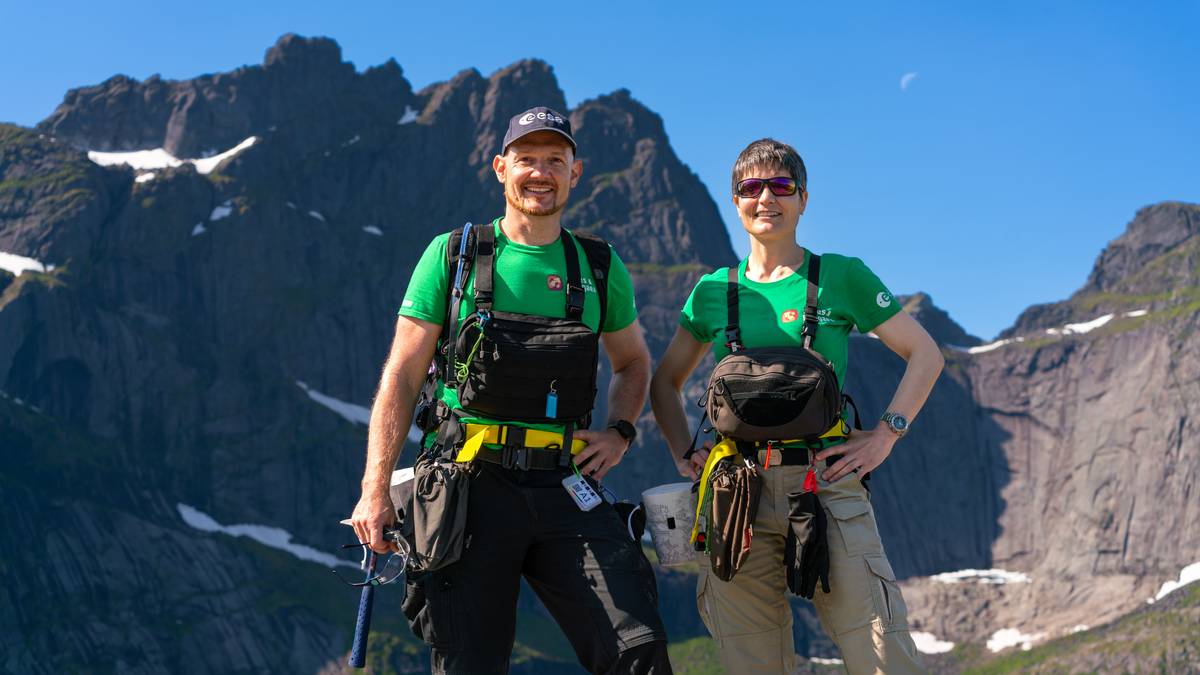Nusfjord in Lofoten is perhaps best known as one of Norway’s oldest and best preserved fishing villages.
But it is not lapping seas, fish and rudders that draw astronauts to the fjord.
The mountains in Nusfjord contain large amounts of anorthosite – a rock of crystallized magma.
This rock is also found on the moon.
ESA astronaut Samantha Cristoforetti has been awarded a stone. With a magnifying glass, she tries to recognize the various minerals.
Photo: Vittorio Crobu / ESA
The PANGAEA course had started in 2019, but was put on hold during the pandemic.
But both last year and this year, astronauts from NASA and ESA have been able to practice in Lofoten.
– The goal is for them to be able to make the right choice when collecting rocks on the moon, says geology and local expert Kåre Kullerud.
Kåre Kullerud (right) has helped train the astronauts in geology. Here from the project’s test period in 2019.
Photo: Sirio Sechi / ESA
The highlands of the moon in Nusfjord
If you look up at the moon in a dark night sky you can see some dark parts and some bright ones.
The bright parts of the moon are called for highlands of the moon. The highlands consist largely of anorthosite, a rock with a lot of plagioclase.
An anorthosite consists of more than 90 percent plagioclase – a mineral that is formed by the crystallization of magma. The rest is either pyroxene or olivine.
It is this type of rock that the astronauts must learn to recognize in the field.
– Presumably what the astronauts find here in Nusfjord is much of what they can also find in the bright areas of the moon, says Kullerud.
The astronauts spent just over a week in Lofoten to learn about rocks and minerals. First in a classroom, then in the field.
– They walk around and tell us over the radio what they see. They decide whether to take pictures, samples or carry out investigations.
– We send them out where we know there is a change in rock types, so if we know there is something they haven’t seen, we have to ask them to go back and look again.
ESA astronaut Alexander Gerst (centre) in the field in Nusfjord.
Photo: Vittorio Crobu / ESA
First man on the moon since 1972
In 2017, NASA started the Artemis program. The goal is to send humans back to the moon.
But before man can set foot on the moon’s surface, he must be tested.
Artemis 1: Was launched in 2022. This was a test of the rocket and spacecraft without humans.
Artemis 2: To be launched during 2024. Four people will be on board, but the rocket will never land on the moon.
If all goes as planned, Artemis 3 will land on the moon in late 2025, but it will probably not before the eighth yearr. It will be the first manned moon landing since 1972.
But who will be on board has not been decided yet.
– Last year we had a NASA astronaut on the course, so there is a certain probability that maybe she will be the first woman on the moon, says Kullerud.
The NASA astronaut Kullerud is talking about is American Kathleen “Kate” Rubins.
In 2022, astronaut Andreas Mogensen and astronaut Kathleen “Kate” Rubins were on the PANGAEA course in Lofoten.
Photo: VITTORIO CROBU / ESA
Rubin’s is one of 18 astronauts in NASA’s Artemis team. Four of these will take part in the moon landing with Artemis 3.
If she is allowed to join, she and the three other astronauts will spend approximately one week on the moon to conduct research.
Then the PANGAEA course comes in handy.
– There isn’t much else to look at than stone, says Kullerud.
– Humanity is driven forward by curiosity. Once you have taken the astronauts to the moon, you might as well try to find out what it consists of.
In Nusfjord in Lofoten, astronauts have walked around the terrain to learn about rock.
Photo: Vittorio Crobu / ESA
2023-08-06 20:37:49
#Astronauts #learn #rocks #Lofoten #preparation #moon #landing

